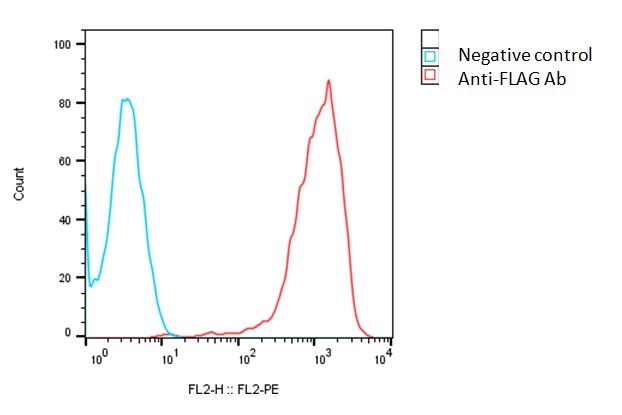
| Catalog Number | Product | Size | Price | |
|---|---|---|---|---|
| C3049 | Human TMIGD2-CHO-K1 Stable Cell Line | 2 vials | $3950 | Order |
| Catalog Number | C3049 |
|---|---|
| Cell Line Name | Human TMIGD2-CHO-K1 Stable Cell Line |
| Accession Number | NM_144615.3, with an N-terminal FLAG tag |
| Host Cell | Adherent CHO-K1 |
| Quantity | Two vials of frozen cells (2x106 per vial) |
| Culture Medium | DMEM with 10% FBS, 4 µg/ml puromycin |
| Freezing Medium | 90% FBS and 10% DMSO |
| Storage | Liquid nitrogen upon receipt |
| Product Datasheet: | Download PDF |
Detection of human TMIGD2 expression on human TMIGD2-CHO-K1 stable cells using an anti-FLAG tag antibody (Accurus, #A1001), followed by staining with PE-anti mouse antibody.

TMIGD2 (Transmembrane and Immunoglobulin Domain Containing 2, CD28H, IGPR1, and IGPR-1), is a transmembrane protein that contains immunoglobulin-like domains. TMIGD2 is expressed on naïve T cells, memory T lymphocytes, tissue-resident T cells (TRMs), NK cells, plasmacytoid dendritic cells (PDCs), and innate lymphoid cells (ILCs). As an adhesion molecule, previous studies have shown that TMIGD2 plays a vital role in cell–cell interactions, cell migration, and angiogenesis. In immune responses, TMIGD2 binds to HHLA-2 to produce co-stimulatory and inhibitory processes, depending on their environment. Irregular expression of TMIGD2 has been associated with cancer progression as high levels may lead to increased proliferation, migration, invasion, and resistance to apoptosis in cancer cells.
Janakiram M, Shah UA, Liu W, Zhao A, Schoenberg MP, Zang X. The third group of the B7-CD28 immune checkpoint family: HHLA2, TMIGD2, B7x, and B7-H3. Immunol Rev. 276:26-39. 2017.
Li Y, Lv C, Yu Y, Wu B, Zhang Y, Lang Q, Liang Z, Zhong C, Shi Y, Han S, Xu F, Tian Y. KIR3DL3-HHLA2 and TMIGD2-HHLA2 pathways: The dual role of HHLA2 in immune responses and its potential therapeutic approach for cancer immunotherapy. J Adv Res. 47:137-150. 2023.
Boulhen C, AitSsi S, Benthami H, Razzouki I, Lakhdar A, Karkouri M, Badou A. TMIGD2 as a potential therapeutic target in glioma patients. Front Immunol. 14:1173518. 2023.